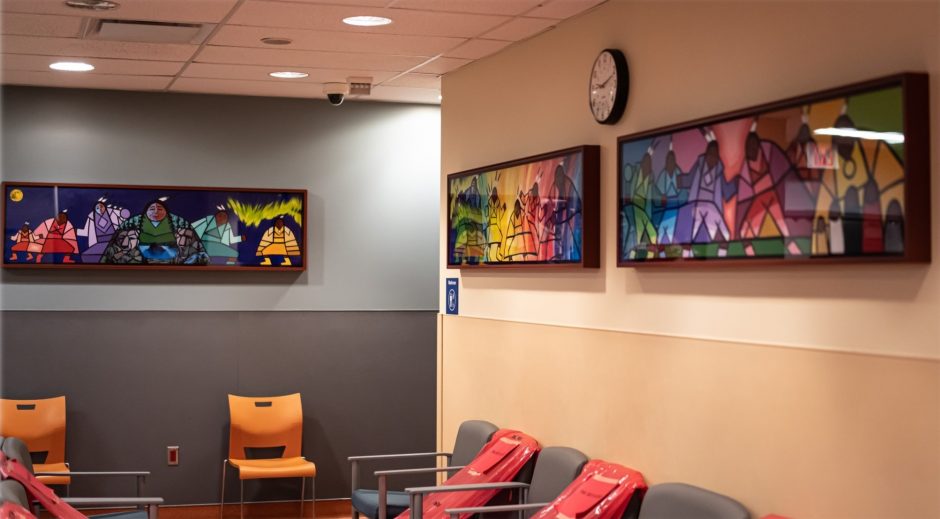Sustaining action and maintaining momentum means a “new normal”: achieving a culture of equity. This will be supported by:
- having visible actions on a regular basis (even small actions)
- communicating, celebrating and making initiatives or successes visible to leadership, staff, service users and community partners
- continuously aligning policies and resources with equity priorities
- iteratively developing new priorities and strategies
- responding to resistance and push-back in ways that sustain momentum
- developing accountability mechanisms
Having diverse and visible actions at regular times will help to build and sustain momentum toward equity.
Example:
For example, at St. Paul’s Hospital Emergency Department, staff collaborated with the hospital’s Indigenous Health Team to commission and install art by a local Indigenous artist, with the aim of expressing welcome and safety to Indigenous people served. The resulting art transformed the waiting area for everyone, and the process created new interdisciplinary relationships, and collaborations among diverse hospital staff. This change continues to serve as a reminder of the ongoing equity work.

Initiatives and successes can be communicated in diverse ways. For example, some larger hospitals have regular ‘newsletter’ style communications that could feature an ‘equity-corner’.
Community partners, including those representing people with lived experience of the inequities being addressed can be very helpful in all aspects of embedding momentum. Service providers typically appreciate hearing directly from people they serve. They can help show case successes, and help counter push back and resistance.
Anticipating & Countering Resistance

Reactions to equity-oriented actions, especially anti-racism and addressing substance use stigma, will elicit a range of responses, from deep appreciation to entrenched resistance, with sometimes visibly negative reactions such as defensiveness and pushback. Partnering with others in your organization and community can help you to anticipate and counter resistance. For example, at one hospital the equity working group partnered with the Indigenous Team, who were hosting education sessions that helped staff learn about the history of local Indigenous groups and develop skills toward cultural safety – actions that aligned well with the priorities of the working group.
From Step 0 you will have taken stock of the inequities faced by people you serve. From there you can imagine what forms of resistance you might encounter, and strategically form partnerships to pre-empt such resistance. For example, the working group in one hospital in which there was considerable anti-immigrant sentiment in the community partnered with local ethnic and religious organizations to invite and promote participation of hospital staff in annual festivals.
Please access our Ensuring Momentum & Accountability: Countering Resistance to Equity Actions tool for specific strategies related to preparing for and countering resistance and embedding momentum and accountability.
Embedding Accountability Mechanisms

Despite good intentions and best effort toward equity-oriented care, harmful actions in the form of stigma and discrimination will continue. Therefore, accountability mechanisms need to be developed and well supported. These need to include, but not be limited to mechanisms through which patients/clients and staff can have complaints of racism, stigma and discrimination taken seriously and responded to effectively.
Processes for embedding accountability will vary from context to context, and could include:
- making visible and returning to commitments to equity at all levels repeatedly,
- setting and communicating expectations related to these commitments,
- putting effective complaints and reconciliation processes in place.

Make visible and return to equity commitments repeatedly: In the earlier steps you will have worked at the level of your setting and perhaps at a wider organizational level to make an explicit commitment to equity, and any key dimension which you are emphasizing. Make sure these are clearly communicated to all, and reinforced. For example, the practice of regularly acknowledging the land and First People at meetings can keep commitments to cultural safety and antiracism in the foreground.
Set and communicate expectations: Operationalize the commitments to equity by setting expectations and communicating those. This could include such things as making “person-first” language mandatory throughout the organization. It could include mandating gender-inclusive language in all signage and forms. Standards of practice increasingly include clear expectations related to equity and social justice.
Example:
The BC College of Nurses and Midwives recently introduced a practice standard related to Indigenous Cultural Safety, Cultural Humility, and Anti-Racism. Such practice standards can be used to set expectations for practice. Organizations can also draw on commitments made by their health authorities, and develop their own statement regarding their commitment to equity, and how staff will enact it.







